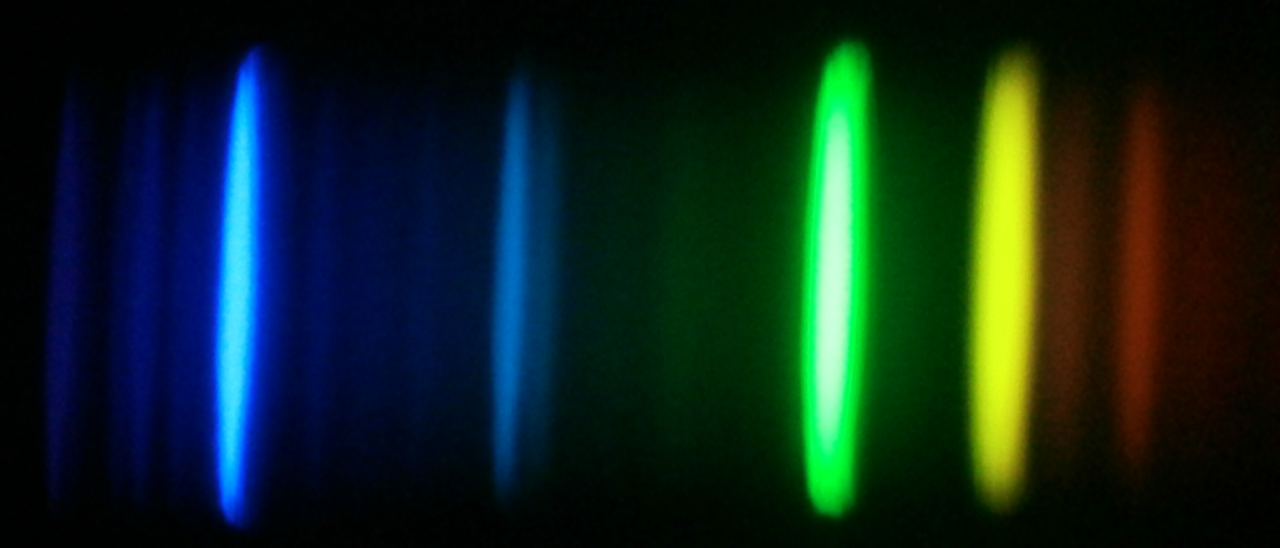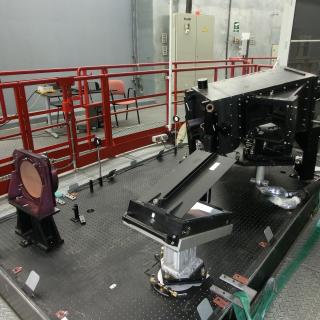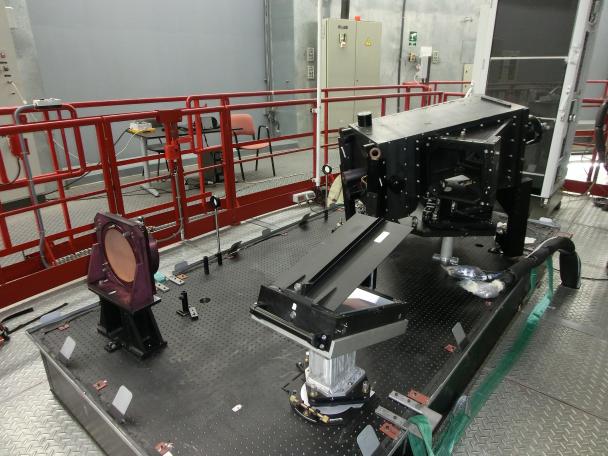Grants related:
General
Stellar spectroscopy allows us to determine the properties and chemical compositions of stars. From this information for stars of different ages in the Milky Way, it is possible to reconstruct the chemical evolution of the Galaxy, as well as the origin of the elements heavier than boron, created mainly in stellar interiors. It is also possible to study stellar formation, and the formation of the Galaxy, from the signature of the Galactic potential on the stellar orbits, and the distributions of mass, ages, and the abundance of heavy elements.
Obtaining high-resolution spectra, as necessary for studies of chemical compositions, requires advanced and efficient instrumentation. This is particularly true for research that calls for large stellar samples, which demands the observation of hundreds or thousands of sources simultaneously. Efficiency requires that the data processing and analysis are performed in an automated way.
The interpretation of spectra is based on physical models of the atmospheres of the stars, from where the light that we observe escapes the stars. The main ingredients for building such models are the fluid dynamics, and the properties of the atoms, ions, and molecules, especially regarding their interactions with the radiation coming from the stellar interior.
Once we have a plausible model, it is possible to compute in detail how the radiation propagates through the stellar atmosphere, and the emergent spectrum, which can then be iteratively compared with the observations to refine the model.
This project covers three different research fronts:
- Improving model atmospheres and simulations of stellar spectra.
- Developing tools for acquisition, reduction, and analysis of spectroscopic observations, in particular for the determination of chemical abundances in stars.
- Designing, preparing, and executing spectroscopic studies of stars aimed at understanding a) the most relevant aspects of the physics of stellar atmospheres, b) the formation and evolution of stars, c) the origin of the chemical elements, and d) the formation, structure, and evolution of the Milky Way galaxy.
Members
Results
- Complete the installation and commissioning of HORuS on GTC
- Discover two new stars with more than 100,000 times less iron than the Sun
- Complete the classification of all the APOGEE spectra with K-means
- Publish a complete collection of model stellar spectra for stars O to M
- Identify the signature of chemical diffusion in the atmospheres of the stars in the cluster M67
Scientific activity
Related publications
-
Star formation in IC1396: Kinematics and subcluster structure revealed by Gaia
Aims: We investigate the star formation history of the IC1396 region by studying its kinematics and completing the population census. Methods: We used multiwavelength data, combining optical spectroscopy to identify and classify new members and near-infrared photometry to trace shocks, jets, and outflows as well as the interactions between the
Pelayo-Baldárrago, Mara E. et al.Advertised on:
12023 -
The Pristine Inner Galaxy Survey (PIGS) - V. A chemo-dynamical investigation of the early assembly of the Milky Way with the most metal-poor stars in the bulge
The investigation of the metal-poor tail in the Galactic bulge provides unique information on the early Milky Way assembly and evolution. A chemo-dynamical analysis of 17 very metal-poor stars (VMP, [Fe/H]<-2.0) selected from the Pristine Inner Galaxy Survey was carried out based on Gemini/GRACES spectra. The chemistry suggests that the majority of
Sestito, Federico et al.Advertised on:
12023 -
The Pristine survey - XIX. Cu and Zn abundances in metal-poor giants
Metal-poor stars formed from a gas enriched by the ejecta of the explosion of one/few generations of first massive stars. With the Pristine photometry combined with the Gaia data, we selected a sample of bright giants metal-poor candidates to be observed at high resolution. Of the 43 stars observed, 36 were confirmed to be metal-poor, supporting
Caffau, E. et al.Advertised on:
12023 -
The Robotic Multiobject Focal Plane System of the Dark Energy Spectroscopic Instrument (DESI)
A system of 5020 robotic fiber positioners was installed in 2019 on the Mayall Telescope, at Kitt Peak National Observatory. The robots automatically retarget their optical fibers every 10-20 minutes, each to a precision of several microns, with a reconfiguration time of fewer than 2 minutes. Over the next 5 yr, they will enable the newly
Silber, Joseph Harry et al.Advertised on:
12023 -
ESPRESSO observations of HE 0107−5240 and other CEMP-no stars with [Fe/H] ≤ -4.5
Context. HE 0107−5240 is a hyper metal-poor star with [Fe/H] = −5.39, one of the lowest-metallicity stars known. Its stellar atmosphere is enhanced in carbon, with [C/Fe] = +4.0, without a detectable presence of neutron-capture elements. Therefore, it belongs to the carbon-enhanced metal-poor (CEMP−no) group, along with the majority of the most
Aguado, D. S. et al.Advertised on:
122022 -
Overview of the Instrumentation for the Dark Energy Spectroscopic Instrument
The Dark Energy Spectroscopic Instrument (DESI) embarked on an ambitious 5 yr survey in 2021 May to explore the nature of dark energy with spectroscopic measurements of 40 million galaxies and quasars. DESI will determine precise redshifts and employ the baryon acoustic oscillation method to measure distances from the nearby universe to beyond
Advertised on:
112022 -
The Gaia-ESO Public Spectroscopic Survey: Motivation, implementation, GIRAFFE data processing, analysis, and final data products
Context. The Gaia-ESO Public Spectroscopic Survey is an ambitious project designed to obtain astrophysical parameters and elemental abundances for 100 000 stars, including large representative samples of the stellar populations in the Galaxy, and a well-defined sample of 60 (plus 20 archive) open clusters. We provide internally consistent results
Gilmore, G. et al.Advertised on:
102022 -
The Gaia-ESO Public Spectroscopic Survey: Implementation, data products, open cluster survey, science, and legacy,★
Context. In the last 15 years different ground-based spectroscopic surveys have been started (and completed) with the general aim of delivering stellar parameters and elemental abundances for large samples of Galactic stars, complementing Gaia astrometry. Among those surveys, the Gaia-ESO Public Spectroscopic Survey, the only one performed on a 8m
Randich, S. et al.Advertised on:
102022 -
Non-LTE abundance corrections for late-type stars from 2000 Å to 3 µm. I. Na, Mg, and Al
Context. It is well known that cool star atmospheres depart from local thermodynamic equilibrium (LTE). Making an accurate abundance determination requires taking those effects into account, but the necessary non-LTE (hereafter NLTE) calculations are often lacking. Aims: Our goal is to provide detailed estimates of NLTE effects for FGK type stars
Lind, K. et al.Advertised on:
92022 -
HD 23472: a multi-planetary system with three super-Earths and two potential super-Mercuries
Context. Comparing the properties of planets orbiting the same host star, and thus formed from the same accretion disc, helps in constraining theories of exoplanet formation and evolution. As a result, the scientific interest in multi-planetary systems is growing with the increasing number of detections of planetary companions. Aims: We report the
Barros, S. C. C. et al.Advertised on:
92022 -
Information content of BP/RP spectra in Gaia DR3
Gaia Data Release 3 has provided the astronomical community with the largest stellar spectroscopic survey to date (> 220 million sources). The low resolution (R~50) blue photometer (BP) and red photometer (RP) spectra will allow for the estimation of stellar atmospheric parameters such as effective temperature, surface gravity, and metallicity. We
Witten, Callum E. C. et al.Advertised on:
112022 -
BACCHUS Analysis of Weak Lines in APOGEE Spectra (BAWLAS)
Elements with weak and blended spectral features in stellar spectra are challenging to measure and require specialized analysis methods to precisely measure their chemical abundances. In this work, we have created a catalog of approximately 120,000 giants with high signal-to-noise Apache Point Observatory Galactic Evolution Experiment (APOGEE) Data
Hayes, Christian R. et al.Advertised on:
92022 -
White Dwarf Binaries across the H-R Diagram
We created the APOGEE-GALEX-Gaia catalog to study white dwarf (WD) binaries. This database aims to create a minimally biased sample of WD binary systems identified from a combination of GALEX, Gaia, and APOGEE data to increase the number of WD binaries with orbital parameters and chemical compositions. We identify 3414 sources as WD binary
Anguiano, Borja et al.Advertised on:
102022 -
Absolute dimensions and apsidal motion of the eclipsing binaries V889 Aquilae and V402 Lacertae
Context. Double-lined eclipsing binaries allow the direct determination of masses and radii, which are key for testing stellar models. With the launch of the TESS mission, many well-known eclipsing binaries have been observed at higher photometric precision, permitting the improvement of the absolute dimension determinations. Aims: Using TESS data
Baroch, D. et al.Advertised on:
92022 -
Photometric and spectroscopic study of the burst-like brightening of two Gaia-alerted young stellar objects
Young stars show variability on different time-scales from hours to decades, with a range of amplitudes. We studied two young stars, which triggered the Gaia Science Alerts system due to brightenings on a time-scale of a year. Gaia20bwa brightened by about half a magnitude, whereas Gaia20fgx brightened by about two and half magnitudes. We analysed
Nagy, Zsófia et al.Advertised on:
92022 -
HORuS transmission spectroscopy and revised planetary parameters of KELT-7 b
We report on the high-resolution spectroscopic observations of two planetary transits of the hot Jupiter KELT-7b (M p = 1.28 ± 0.17M Jup, T eq = 2028 K) observed with the High Optical Resolution Spectrograph (HORuS) mounted on the 10.4-m Gran Telescopio Canarias (GTC). A new set of stellar parameters are obtained for the rapidly rotating parent
Tabernero, H. M. et al.Advertised on:
92022 -
Interpolation of spectra from 3D model atmospheres
Context. The use of 3D hydrodynamical simulations of stellar surface convection for model atmospheres is computationally expensive. Although these models have been available for quite some time, their use is limited because of the lack of extensive grids of simulations and associated spectra. Aims: Our goal is to provide a method to interpolate
Bertran de Lis, S. et al.Advertised on:
52022 -
SEGUE-2: Old Milky Way Stars Near and Far
The Sloan Extension for Galactic Understanding and Exploration 2 (SEGUE-2) obtained 128,288 low-resolution spectra (R ~ 1800) of 118,958 unique stars in the first year of the Sloan Digital Sky Survey III (2008-2009). SEGUE-2 targeted prioritized distant halo tracers (blue horizontal-branch stars, K giants, and M giants) and metal-poor or
Rockosi, Constance M. et al.Advertised on:
42022 -
Accurate Metallicities for Very Metal-poor Stars from the Ca II Infrared Triplet
The Ca II H and K lines are among the few features available to infer the metallicity of extremely metal-poor stars from medium-resolution spectroscopy. Unfortunately, these lines can overlap with absorption produced in the intervening interstellar medium, introducing systematic errors in the derived metallicities. The strength of the Ca II
Martinez Osorio, Yeisson et al.Advertised on:
42022 -
Strong CO absorption features in massive ETGs
Massive Early-Type Galaxies (ETGs) in the local Universe are believed to be the most mature stage of galaxy evolution. Their stellar population content reveals the evolutionary history of these galaxies. However, while state-of-the-art Stellar Population Synthesis (SPS) models provide an accurate description of observed galaxy spectra in the
Eftekhari, Elham et al.Advertised on:
52022
Related talks
No related talks were found.Related conferences
No related conferences were found.News

The IAC is an internationalized Spanish research centre aiming to achieve major advances in the understanding of the laws that govern the origin and evolution of the various forms of matter/energy in the Universe. Outstanding results are expected in key areas of research such as Solar physics, Sun-Earth connections, Exoplanetary systems, Solar







